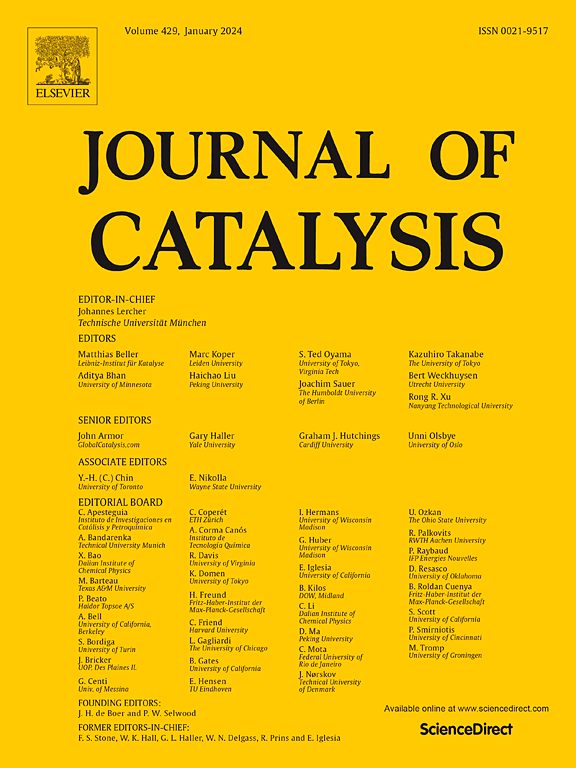铱单原子诱导原位H2O2生成,促进了甲烷与分子O2的水热氧化制甲醇
IF 6.5
1区 化学
Q2 CHEMISTRY, PHYSICAL
引用次数: 0
摘要
甲烷部分氧化制甲醇已成为一个研究领域。对于使用O2作为氧化剂的情况,过度氧化是不希望的,也是不可避免的。为了解决这一问题,我们构建了具有单一活性位点的单原子Ir1/C催化剂,以实现甲醇的高选择性。在这里,我们采用o -吸附调制策略来控制Ir位点上的O2解离路径,其中O2在Ir单原子(SAs)上转化为H2O2,而Ir- o在Ir簇上转化为H2O2。与Ir簇相比,随后在Ir簇上H2O2分解成H2O和*O大大降低了CH4氧化过程的障碍。Operando红外光谱证实了对Ir-OOH的观测,这是Ir-HOOH特异中间体存在的有力证据。H2O2作为Ir-HOOH形成的另一个重要证据也被检测和定量。在0.3 MPa CH4和0.1 MPa空气在150 °C水中加料3 h时,Ir1/C的甲醇产率为17mmol g−1,远高于Ircluster/C (6mmol g−1);在0.3 MPa CH4条件下,Ir1/C的甲醇产率为31.3mmol g−1。本研究表明,通过o吸附调制策略可以实现o参与反应的选择性控制和活性提升。本文章由计算机程序翻译,如有差异,请以英文原文为准。


Iridium single-atoms induced in situ H2O2 formation boosting the hydrothermal oxidation of methane to methanol with molecular O2
Partial oxidation of methane to methanol has become a heavily investigated field. For cases using O2 as oxidant, overoxidation is undesired and inevitable. To address this issue, we construct a single atom Ir1/C catalyst with a unitary active site to achieve a high selectivity of methanol. Here we employed the O-adsorption modulation strategy to control the O2 dissociation path on Ir site, where O2 transforms into H2O2 on Ir single atoms (SAs) in contrast to Ir-O on Ir clusters. The subsequent decomposition of H2O2 into H2O and *O on Ir SAs vastly decreases the barriers of CH4 oxidation process, compared to the Ir clusters. Operando infrared spectroscopy demonstrates the observation of Ir-OOH, a strong evidence for the distinguished intermediate of Ir-HOOH. H2O2 was also detected and quantified as another important evidence for the formation of Ir-HOOH. Ir1/C exhibited a much higher methanol productivity of 17mmol g−1 than Ircluster/C (6mmol g−1) under a feeding of 0.3 MPa CH4 and 0.1 MPa air in water at 150 °C for 3 h, and the value raised to 31.3mmol g−1 under 0.3 MPa CH4. This work demonstrates that selectivity control and activity promotion in O-involved reaction can be realized via the O-adsorption modulation strategy.
求助全文
通过发布文献求助,成功后即可免费获取论文全文。
去求助
来源期刊

Journal of Catalysis
工程技术-工程:化工
CiteScore
12.30
自引率
5.50%
发文量
447
审稿时长
31 days
期刊介绍:
The Journal of Catalysis publishes scholarly articles on both heterogeneous and homogeneous catalysis, covering a wide range of chemical transformations. These include various types of catalysis, such as those mediated by photons, plasmons, and electrons. The focus of the studies is to understand the relationship between catalytic function and the underlying chemical properties of surfaces and metal complexes.
The articles in the journal offer innovative concepts and explore the synthesis and kinetics of inorganic solids and homogeneous complexes. Furthermore, they discuss spectroscopic techniques for characterizing catalysts, investigate the interaction of probes and reacting species with catalysts, and employ theoretical methods.
The research presented in the journal should have direct relevance to the field of catalytic processes, addressing either fundamental aspects or applications of catalysis.
 求助内容:
求助内容: 应助结果提醒方式:
应助结果提醒方式:


